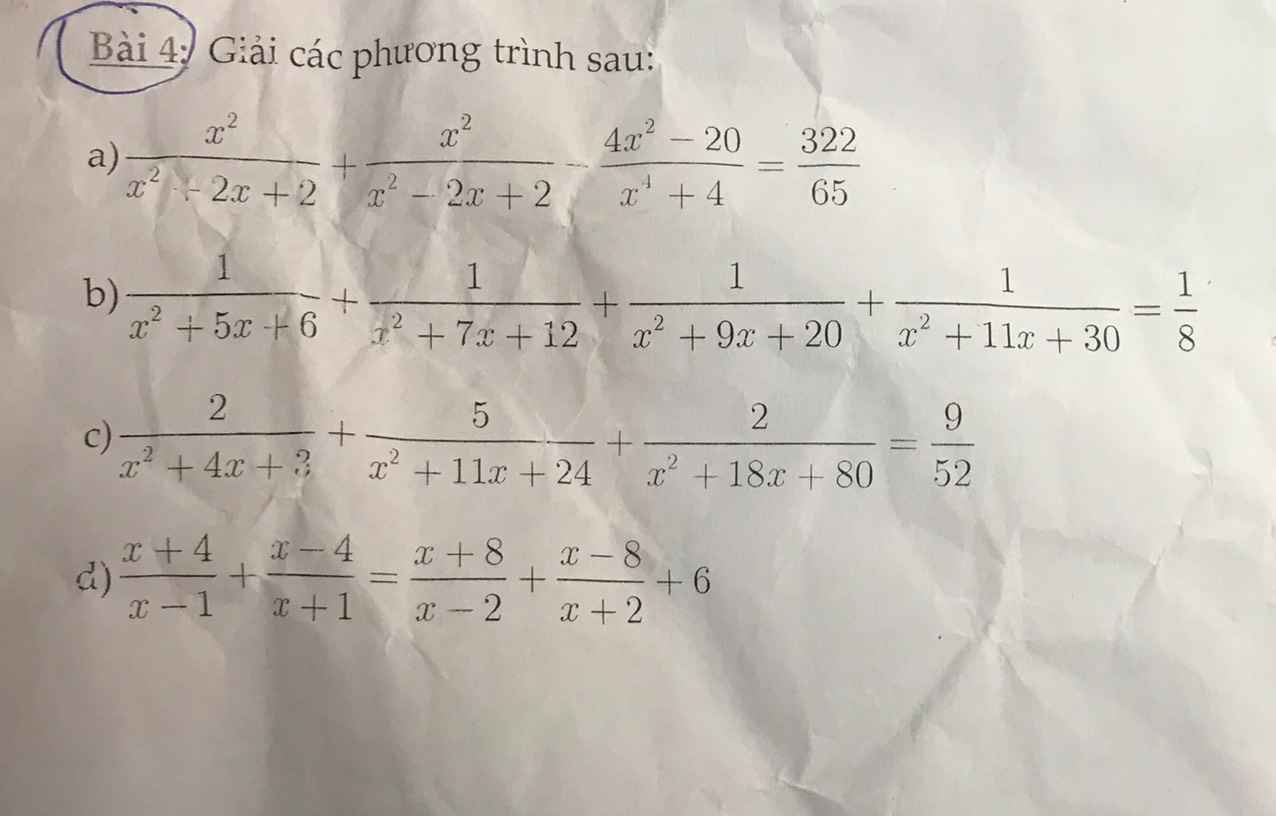
 giải phương trình
giải phương trình
Hãy nhập câu hỏi của bạn vào đây, nếu là tài khoản VIP, bạn sẽ được ưu tiên trả lời.


Bạn bấm vào biểu tượng ![]() để nhập các công thức toán học cho rõ ràng nhé!
để nhập các công thức toán học cho rõ ràng nhé!
Vd:\(3^{10}\)

Ta thấy \(100⋮4,100-x⋮4\Rightarrow x⋮4\)
\(18⋮9,90⋮9,18+90+x⋮9\Rightarrow x⋮9\)
Điều này có nghĩa là \(x\in BC\left(9,4\right)=\left\{0,36,72,108,...\right\}\)
Tuy nhiên, vì \(x\le22\) nên \(x=0\) là số tự nhiên x duy nhất thỏa mãn đề bài.
Lời giải:
$100-x\vdots 4$. Mà $100\vdots 4\Rightarrow x\vdots 4$
$18+90+x\vdots 9$, mà $18\vdots 9, 90\vdots 9$ nên $x\vdots 9$
Vậy $x\vdots 4, x\vdots 9$
$\Rightarrow x\vdots 36$
Mà $x$ là số tự nhiên không vượt quá $22$ nên $x=0$

$18\times\left(\frac{19191919}{21212121}+\frac{88888}{99999}\right)$
$=18\times\left(\frac{19}{21}+\frac{8}{9}\right)$
$=18\times\frac{113}{63}=\frac{226}{7}$
Lời giải:
$18\times (\frac{19191919}{21212121}+\frac{88888}{99999})$
$=18\times (\frac{19}{21}+\frac{8}{9})=18\times \frac{113}{63}=\frac{226}{7}$

Lời giải:
$111\times 113\times 117\times 119=\overline{....3}\times 117\times 119$
$=\overline{....1}\times 119=\overline{...9}$
Vậy tích trên có tận cùng là 9.
Có : 1 x 3 x 7 x 9 = 3 x 7 x 9 = 21 x 9 = 189
⇒ Chữ số tận cùng của kết quả dãy tính 111 x 113 x 117 x 119 là 9.

\(\overline{ab}\times\overline{ab}-8557=0\\ \Rightarrow\left(\overline{ab}\right)^2=8557\)
Nhận xét:
\(\left(\overline{ab}\right)^2\) là số chính phương; 8557 không phải số chính phương
Do đó kết quả sai
Vậy...
Lời giải:
$\overline{ab}\times \overline{ab}=8557$
Nếu kết quả trên là đúng, thì $b\times b$ có tận cùng là 7.
Nhưng ta thấy rằng, không có 2 số tự nhiên nào nhân với nhau có tận cùng là $7$.
$1\times 1=1$
$2\times 2=4$
$3\times 3=9$
$4\times 4=16$
$5\times 5=25$
$6\times 6=36$
$7\times 7=49$
$8\times 8=64$
$9\times 9=81$.
Do đó kết quả trên là sai.


a) 248 x 36 + 4 x 64 x 62
= 2 x 124 x 36 + (2 x 62) x 2 x 64
= 72 x 124 + 124 x 128
= 124 x (72 + 128)
= 124 x 200
= 124 x 2 x 100
= 248 x 100
= 24800
b) 567 x 65 + 567 x 35 + 5670
= 567 x 65 + 567 x 35 + 5670
= 567 x (65 + 35) + 5670
= 567 x 100 + 5670
= 56700 + 5670
= 62370

\(\dfrac{x-2y}{z-y}=-5\Rightarrow\dfrac{x-2y}{y-z}=5\\ \Rightarrow x-2y=5\left(y-z\right)\\ \Rightarrow x-2y=5y-5z\\ \Rightarrow x+5z=7y\)
Ta có:
\(\dfrac{1}{7}\cdot\dfrac{x-2z}{y-z}=\dfrac{x-2z}{7\left(y-z\right)}=\dfrac{x-2z}{7y-7z}\\ =\dfrac{x-2z}{x+5z-7z}=\dfrac{x-2z}{x-2z}=1\)
\(\Rightarrow\dfrac{x-2z}{y-z}=1:\dfrac{1}{7}=7\)
Bài 4:
d:
ĐKXĐ: \(x\notin\left\{1;-1;2;-2\right\}\)
\(\dfrac{x+4}{x-1}+\dfrac{x-4}{x+1}=\dfrac{x+8}{x-2}+\dfrac{x-8}{x+2}+6\)
=>\(\dfrac{\left(x+4\right)\left(x+1\right)+\left(x-4\right)\left(x-1\right)}{\left(x-1\right)\left(x+1\right)}=\dfrac{\left(x+8\right)\left(x+2\right)+\left(x-8\right)\left(x-2\right)+6\left(x-2\right)\left(x+2\right)}{\left(x-2\right)\left(x+2\right)}\)
=>\(\dfrac{2x^2+8}{\left(x-1\right)\left(x+1\right)}=\dfrac{2x^2+32+6x^2-24}{\left(x-2\right)\left(x+2\right)}\)
=>\(\dfrac{2x^2+8}{x^2-1}=\dfrac{8x^2+8}{x^2-4}\)
=>\(\left(2x^2+8\right)\left(x^2-4\right)=\left(8x^2+8\right)\left(x^2-1\right)\)
=>\(2x^4-32=8x^4-8\)
=>\(-6x^4=24\)
=>\(x^4=-4\left(loại\right)\)
Vậy: Phương trình vô nghiệm
c:
ĐKXĐ: \(x\notin\left\{-1;-3;-8;-10\right\}\)
\(\dfrac{2}{x^2+4x+3}+\dfrac{5}{x^2+11x+24}+\dfrac{2}{x^2+18x+80}=\dfrac{9}{52}\)
=>\(\dfrac{2}{\left(x+1\right)\left(x+3\right)}+\dfrac{5}{\left(x+3\right)\left(x+8\right)}+\dfrac{2}{\left(x+8\right)\left(x+10\right)}=\dfrac{9}{52}\)
=>\(\dfrac{1}{x+1}-\dfrac{1}{x+3}+\dfrac{1}{x+3}-\dfrac{1}{x+8}+\dfrac{1}{x+8}-\dfrac{1}{x+10}=\dfrac{9}{52}\)
=>\(\dfrac{1}{x+1}-\dfrac{1}{x+10}=\dfrac{9}{52}\)
=>\(\dfrac{9}{\left(x+1\right)\left(x+10\right)}=\dfrac{9}{52}\)
=>(x+1)(x+10)=52
=>\(x^2+11x-42=0\)
=>(x+14)(x-3)=0
=>\(\left[{}\begin{matrix}x=-14\left(nhận\right)\\x=3\left(nhận\right)\end{matrix}\right.\)
b:
ĐXKĐ: \(x\notin\left\{-2;-3;-4;-5;-6\right\}\)\(\dfrac{1}{x^2+5x+6}+\dfrac{1}{x^2+7x+12}+\dfrac{1}{x^2+9x+20}+\dfrac{1}{x^2+11x+30}=\dfrac{1}{8}\)
=>\(\dfrac{1}{\left(x+2\right)\left(x+3\right)}+\dfrac{1}{\left(x+3\right)\left(x+4\right)}+\dfrac{1}{\left(x+4\right)\left(x+5\right)}+\dfrac{1}{\left(x+5\right)\left(x+6\right)}=\dfrac{1}{8}\)
=>\(\dfrac{1}{x+2}-\dfrac{1}{x+3}+\dfrac{1}{x+3}-\dfrac{1}{x+4}+\dfrac{1}{x+4}-\dfrac{1}{x+5}+\dfrac{1}{x+5}-\dfrac{1}{x+6}=\dfrac{1}{8}\)
=>\(\dfrac{1}{x+2}-\dfrac{1}{x+6}=\dfrac{1}{8}\)
=>\(\dfrac{x+6-x-2}{\left(x+2\right)\left(x+6\right)}=\dfrac{1}{8}\)
=>(x+2)(x+6)=32
=>\(x^2+8x-20=0\)
=>(x+10)(x-2)=0
=>\(\left[{}\begin{matrix}x=-10\left(nhận\right)\\x=2\left(nhận\right)\end{matrix}\right.\)
a: \(\dfrac{x^2}{x^2+2x+2}+\dfrac{x^2}{x^2-2x+2}-\dfrac{4x^2-20}{x^4+4}=\dfrac{322}{65}\)
=>\(\dfrac{x^2\left(x^2-2x+2\right)+x^2\left(x^2+2x+2\right)-4x^2+20}{\left(x^2+2x+2\right)\left(x^2-2x+2\right)}=\dfrac{322}{65}\)
=>\(\dfrac{x^4-2x^3+2x^2+x^4+2x^3+2x^2-4x^2+20}{x^4+4}=\dfrac{322}{65}\)
=>\(\dfrac{2x^4+20}{x^4+4}=\dfrac{322}{65}\)
=>\(322\left(x^4+4\right)=65\left(2x^4+20\right)\)
=>\(322x^4+1288-130x^4-1300=0\)
=>\(192x^4=12\)
=>\(x^4=\dfrac{1}{16}\)
=>\(\left[{}\begin{matrix}x=\dfrac{1}{2}\left(nhận\right)\\x=-\dfrac{1}{2}\left(nhận\right)\end{matrix}\right.\)